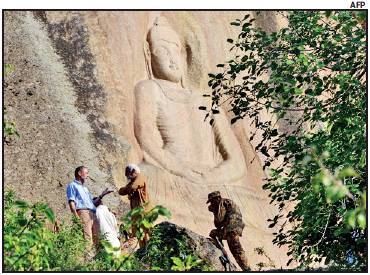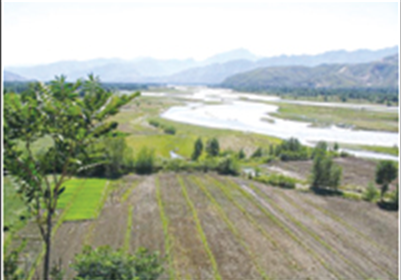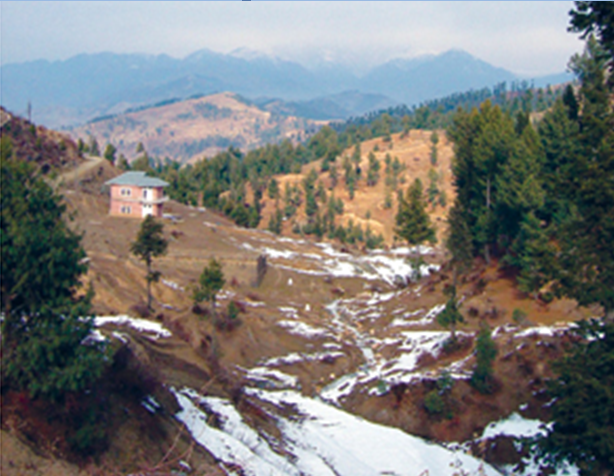Swat Valley
(→Swat) |
|||
| Line 96: | Line 96: | ||
It hurts to know that Swat should have fallen prey to such madness and become a battleground, where orchards thrive under the peaceful remains of the bygone Buddhist, Gandhara civilisation, and handicrafts and tourism were what put this beautiful valley on the world tourism map. | It hurts to know that Swat should have fallen prey to such madness and become a battleground, where orchards thrive under the peaceful remains of the bygone Buddhist, Gandhara civilisation, and handicrafts and tourism were what put this beautiful valley on the world tourism map. | ||
| + | |||
| + | =The Buddha of Swat= | ||
| + | ==2018: Restoration of sculpture dynamited by Taliban== | ||
| + | [https://epaper.timesgroup.com/Olive/ODN/TimesOfIndia/shared/ShowArticle.aspx?doc=TOIDEL%2F2018%2F07%2F13&entity=Ar02803&sk=9A514824&mode=text Dynamited by Taliban, Buddha of Swat smiles again after 11 yrs, July 13, 2018: ''The Times of India''] | ||
| + | |||
| + | [[File: The seventh-century rock sculpture of a seated Buddha carved into a mountain in Jahanabad town in Swat Valley of Pakistan has been restored by Italian archaeologists after the Taliban defaced it in 2007.jpg|The seventh-century rock sculpture of a seated Buddha carved into a mountain in Jahanabad town in Swat Valley of Pakistan has been restored by Italian archaeologists after the Taliban defaced it in 2007 <br/> From: [https://epaper.timesgroup.com/Olive/ODN/TimesOfIndia/shared/ShowArticle.aspx?doc=TOIDEL%2F2018%2F07%2F13&entity=Ar02803&sk=9A514824&mode=text Dynamited by Taliban, Buddha of Swat smiles again after 11 yrs, July 13, 2018: ''The Times of India'']|frame|500px]] | ||
| + | |||
| + | The iconic Buddha of Swat, carved on a cliff in the 7th century, has been restored to its almost original form with Italian assistance in the troubled northwestern Pakistan, nearly 11 years after it was dynamited by the banned Tehreek-e-Taliban Pakistan during their control over the area. | ||
| + | |||
| + | Buddha seated in a meditative posture, which is considered one of the largest rock sculptures in South Asia, was attacked in September 2007 by the Taliban militants, who blew up over half the statue’s face by drilling holes into the face and shoulders and inserting explosives, triggering a worldwide anger. | ||
| + | |||
| + | The Italian government invested €2.5 million ($2.9 million) in five years to preserve the cultural heritage and restore the six-metre tall Buddha of Swat, depicted in a lotus position at the base of a granite cliff. Luca Maria Olivieri, an Italian archaeologist who oversaw the restoration, said the rehabilitation of the site has not been easy. He said the reconstruction is not identical, but that is deliberate, as “the idea of damage should remain visible”. The restoration started in 2012 in phases with the application of a coating to protect the damaged part of the sculpture. The reconstruction of the face itself was first prepared virtually in the laboratory, in 3D, using laser surveys and old photos. | ||
| + | |||
| + | The last phase, the actual restoration of Buddha of Swat, ended in 2016. Now the authorities are counting on Buddha’s recovered smile and iconic status to boost religious tourism, he added. | ||
Latest revision as of 21:22, 13 July 2018
This is a collection of articles archived for the excellence of their content. Readers will be able to edit existing articles and post new articles directly |
Contents |
[edit] The Valley
[edit] I
May 24, 2008
A trip to Swat valley
By Jazba Laraib
I am very fond of travelling and I love to explore new places. Visiting different places is my hobby and my father always helps me in arranging trips despite his busy schedule. I have seen many places in Pakistan but the trip to Swat valley is nothing less than a beautiful dream for me. Today I wish to share with you an interesting and enthusiastic journey to the beautiful Swat valley. My excitement knew no bounds when I learned that we were going to Swat. To add fun and to lessen our tension, we planned to travel in our own car.
We started our journey at 5:00am from our city Layyah, in southern Punjab. After an exhausting journey, we reached Kohat, a city in Khyber-Pakhtunkhwa (old NWFP), to pick my younger brother from Cadet College Kohat. We then proceeded towards Peshawar, the capital of Khyber-Pakhtunkhwa (old NWFP).
We reached Peshawar at 3:00 in the afternoon, and proceeded to the hotel. The next day we resumed our journey to Swat valley. Our first stay was in Mingora, a small city of Swat valley. On the way we passed from the cities of Chasadda, Mardan, Dargai, Bat Khela and Bari Kot.
Besides being a beautiful valley, Swat is historically interesting as well. It offers hundreds of archaeological sites spanning 5000 years of history. For the sportsman and trekkers, it offers good fishing and hiking opportunities.
Saidu Sharif and Mingora are twin towns, two kilometres apart. Saidu Sharif is the administrative capital of Swat division while Mingora is the district headquarters and main bazaar area. Both are 990m above sea level.
We reached Mingora after a five-hour drive, and proceeded towards the hotel, which is at a distance of 2km from the main city. The hotel itself was very beautiful and worth seeing building. The building was very old, built in the 19th century. The hotel has a small zoo and some shops of its own. We had lunch there and then I went out with my mother to buy some items from the shops.
We spent the whole day there and the next day we went out for our next point, Kalam. On the way to Kalam, we saw Swat Museum which is on the east side of the street, halfway between Mingora and Saidu. The museum is a worth seeing place for visitors especially for history lovers.
Mingora’s main market is a nice place for shopping. It’s just like shopping malls in big cities like Karachi and Lahore.
Afterwards, we visited Islampur, which is a village two kilometres off the main Saidu-Marghazar road, where visitors can see handloom weaving and buy hand-woven shawls and blankets.
At 12:00 noon, we reached Kalam. On the way to Kalam, a road turned to the most important ski-resort of Pakistan, Malam Jabba. We reached there after a three-hour drive from Mingora. The road of Malam was very dangerous for driving, especially for untrained drivers. I was very scared during the whole journey to Malam Jabba.
The next point or small town on the way to Kalam is Khwazakhela, which is about 30 km from Mingora on the east bank of Swat River. Khwazakhela is the largest commercial centre in this part of the valley. From there the view of Swat River is too beautiful.
After that we reached Miandam — a small summer resort at 1,800 metres, 10 kilometres up, a steep side valley and 56 kilometres from Saidu Sharif. This is a good place for walkers. The most attractive thing for visitors is the orchards of apples, pears, honey and other fruits.
Another resort we visited was Madyan. It is a tourist resort on the Swat River. At 1,321m above the sea level, it is not as cool as Miandam, but it expands over a large area and has many shops. Antique and modern shawls, traditional embroidery, tribal jewellery and carved wooden items are sold along the main street.
North of Madyan is Swat Kohistan where walking is not recommended without an armed guard.
From Madyan, we went to Bahrain, which is 10 kilometres north of Madyan and only slightly higher, at above 1, 400 metres. It is another popular riverside tourist resort, with bazaars worth exploring for their handicrafts. It is about 29 kilometres away from Kalam. The road was dangerous, so we hired a taxi from Bahrain and left our car at the taxi stand there. Then we started our journey to Kalam. We reached Kalam in one hour. We saw many waterfalls on the way to Kalam and I captured most of them in my camera. Kalam is about 2,000 metres above sea level and the valley provides rooms for a small but fertile plateau above the river. We reached there in the evening and checked in a hotel. As our hotel was situated in the main market, after having dinner, I went to the bazaar with my father. We came back at 11:00pm and went to sleep.
The next day we planned to go to Ushu River, I had heard that the place was very beautiful but the way to the river was very dangerous, as after Kalam there was no metallic road, but I persuaded my family to go there at the cost of our lives. We hired a jeep and went for Ushu River and a waterfall there. Thank God we didn’t meet any accident in our whole journey.
Beyond Kalam the road divides. A dirt road follows the Ushu and Utrot rivers. All was going well, but we all were afraid as well as thrilled which increased the fun of the journey. Anyways after an hour, we reached at a glacier. There we spent some time and then decided to go back to avoid further risk of the dangerous journey. We came back to our hotel in the same jeep.
This ended our beautiful journey and the next day we departed for our hometown bringing with us the beautiful memories of the Swat valley.
[edit] II
Text and photos by K. B. Abro
Summer of 2000, Tehran: we went there for our holidays. My friend Mostafa Hoshangi, an architect and model-maker by profession, was busy playing with Suhaee, my younger daughter. I asked him about the north of Iran, how to go there and what to see, etc. He smiled and asked me, “Have you seen your north?”
“No,” I immediately replied.
He then told us how beautiful our northern valleys were. Anyway, we saw Iran’s north and enjoyed the combination of the mountains and the Caspian Sea. But we decided that our next destination would be our Northern Areas.
A couple of years later, during winter holidays, we went to Swat. I called my friend Mohammed Riaz in Peshawar. He told us the weather was harsh and that the roads were closed; the tourist season was off so the hotels were also closed. It would be even more difficult with children. Despite the warning, we decided to continue with our plans. Now our friends joke that during the summer we stay in the desert and in winter we go towards the mountains.
Short of the Northern Areas, we headed off to Swat in winter. On December 25, we saw pine trees bent downwards with the weight of the snow, just like what we had seen in pictures or in the movies. The road to Kalam felt like a snowy dream or part of a beautifully illustrated book on Christmas.
Starting from that trip, we have now toured almost the whole of our Northern Areas, too. We would take a bus from Karachi to Peshawar, start our journey in the wee hours of the morning and reach Peshawar the next morning. It was very economical and a great experience to journey through the whole country in 24 hours with different kinds of people for companions.
When the holiday season begins, the newspapers are full of articles on travel providing one with suggestions to travel to foreign destinations and see beautiful places in other countries; very few suggest touring the beautiful places in our own country, which is also more economical.
Since the first visit there, Swat has become our love. We have spent our summer and winter vacations there. We go there to forget our noisy, smoke-filled and polluted city, to breathe in the fresh air, to hear the birds sing, to hear the sound of the River Swat, to capture the beauty of places like Fizaghat, Marghzar, Miandam and Kalam. Now all we see in newspapers and on television are explosions, bombardments, smoke and sirens.
The rulers are telling the world that they should remain in power to protect the country from the so-called threat posed by terrorists, extremists and suicide bombers.
It hurts to know that Swat should have fallen prey to such madness and become a battleground, where orchards thrive under the peaceful remains of the bygone Buddhist, Gandhara civilisation, and handicrafts and tourism were what put this beautiful valley on the world tourism map.
[edit] The Buddha of Swat
[edit] 2018: Restoration of sculpture dynamited by Taliban
Dynamited by Taliban, Buddha of Swat smiles again after 11 yrs, July 13, 2018: The Times of India

From: Dynamited by Taliban, Buddha of Swat smiles again after 11 yrs, July 13, 2018: The Times of India
The iconic Buddha of Swat, carved on a cliff in the 7th century, has been restored to its almost original form with Italian assistance in the troubled northwestern Pakistan, nearly 11 years after it was dynamited by the banned Tehreek-e-Taliban Pakistan during their control over the area.
Buddha seated in a meditative posture, which is considered one of the largest rock sculptures in South Asia, was attacked in September 2007 by the Taliban militants, who blew up over half the statue’s face by drilling holes into the face and shoulders and inserting explosives, triggering a worldwide anger.
The Italian government invested €2.5 million ($2.9 million) in five years to preserve the cultural heritage and restore the six-metre tall Buddha of Swat, depicted in a lotus position at the base of a granite cliff. Luca Maria Olivieri, an Italian archaeologist who oversaw the restoration, said the rehabilitation of the site has not been easy. He said the reconstruction is not identical, but that is deliberate, as “the idea of damage should remain visible”. The restoration started in 2012 in phases with the application of a coating to protect the damaged part of the sculpture. The reconstruction of the face itself was first prepared virtually in the laboratory, in 3D, using laser surveys and old photos.
The last phase, the actual restoration of Buddha of Swat, ended in 2016. Now the authorities are counting on Buddha’s recovered smile and iconic status to boost religious tourism, he added.







